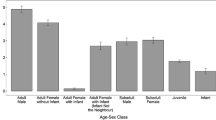Abstract
Quantitative methods of observation and analysis were used in a 12-month study of grooming behavior of free-rangingMacaca mulatta on La Cueva Island at La Parguera, Puerto Rico. Observations lasting 30–120 minutes were made from eight positions on the island at a standard time of day when monkeys were either feeding or resting. Two dependent variables were obtained: (1) the number of monkeys present in the observation area were noted by age and sex class at five-minute intervals throughout each observation, and (2) the frequency of grooming encounters was tabulated by the age and sex class(es) of groomer and recipient. These data were computed as grooms/hour/possible interacting combination of monkeys. Grooming frequencies were higher in non-feeding situations than when monkeys were feeding. The largest social group had the lowest mean grooming rates, while the smallest group had the highest grooming frequencies. More grooming occurred during the November-to-February mating season than at other periods of the year. Adult females were involved in over 60% of all grooming behavior, juveniles participated in 25% of the grooming, while adult males groomed females, primarily during the mating season, and rarely groomed other males or juveniles. Genealogical relationships, levels of group aggression and the feeding or resting context all influenced the frequency of grooming. This study provides support for the hypothesis that the basic social unit for rhesus macaques consists of a core of adult females with their juvenile and infant progeny.
Similar content being viewed by others
References
Altmann, S. A., 1962. A field study of the sociobiology of rhesus monkeys,Macaca mulatta.Annals N.Y. Acad. Sci., 102: 338–435.
Bernstein, I. S. &L. G. Sharpe, 1966. Social roles in a rhesus monkey group.Behaviour, 26: 91–104.
Boelkins, R. C. &A. P. Wilson, 1972. Intergroup dynamics of the Cayo Santiago rhesus (Macaca mulatta) with special reference to changes in group membership by males.Primates, 13: 125–139.
Carpenter, C. R., 1942. Sexual behavior of free-ranging rhesus monkeys (Macaca mulatta). I. Specimens, procedures and behavioral characteristics of estrus.J. Comp. Psychol., 33: 113–142.
Drickamer, L. C., 1974. A ten-year summary of population and reproductive data for free-rangingMacaca mulatta at La Parguera, Puerto Rico.Folia primat., 21: 61–80.
————, 1975. Patterns of space utilization by an island colony of free-ranging rhesus monkeys.Primates, 16: 23–33.
————, 1975. Quantitative observations of behavior in free-rangingMacaca mulatta. I. Methodology and Aggression.Behaviour, 55: 209–236.
———— &S. H. Vessey, 1973. Group-changing behavior among male rhesus monkeys.Primates, 14: 359–368.
Kaufman, J. H., 1965. A three-year study of mating behavior in a free-ranging band of rhesus monkeys.Ecology, 46: 500–512.
————, 1967. Social relations of adult males in a free-ranging band of rhesus monkeys. In:Social Communication Among Primates,S. A. Altmann (ed.), Univ. of Chicago Press, Chicago.
Koford, C. B., 1966. Population changes in rhesus monkeys: Cayo Santiago 1960–1964.Tulane Stud. Zool., 13: 1–7.
Loy, J., 1970. Behavioral responses of free-ranging rhesus monkeys to food shortage.Amer. J. Phys. Anthrop., 33: 263–272.
————, 1971. Estrous behavior of free-ranging rhesus monkeys (Macaca mulatta).Primates, 12: 1–31.
Sade, D. S., 1965. Some aspects of parent-offspring and sibling relations in a group of rhesus monkeys, with a discussion of grooming.Amer. J. Phys. Anthrop., 23: 1–17.
Sparks, J., 1967. Allogrooming in primates: a review. In:Primate Ethology,D. Morris (ed.), Aldine Publ. Co., Chicage.
Vandenbergh, J. G., 1967. The development of social structure in free-ranging rhesus monkeys.Behaviour, 29: 179–194.
————, 1969. Endocrine coordination in monkeys: Male sexual responses to females.Physiol. Behav., 4: 261–264.
———— &L. C. Drickamer, 1974. Reproductive coordination among free-ranging rhesus monkeys.Physiol. Behav., 13: 373–376.
———— &S. H. Vessey, 1968. Seasonal breeding of free-ranging rhesus monkeys and related ecological factors.J. Reprod. Fertil., 15: 71–79.
Washburn, S. L. &I. DeVore, 1961. Social behavior of baboons and early man. In:Social Life of Early Man,S. L. Washburn (ed.), Aldine Publ. Co., Chicago.
Author information
Authors and Affiliations
About this article
Cite this article
Drickamer, L.C. Quantitative observations of grooming behavior in free-rangingMacaca mulatta . Primates 17, 323–335 (1976). https://doi.org/10.1007/BF02382789
Received:
Accepted:
Issue Date:
DOI: https://doi.org/10.1007/BF02382789




